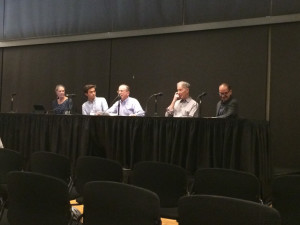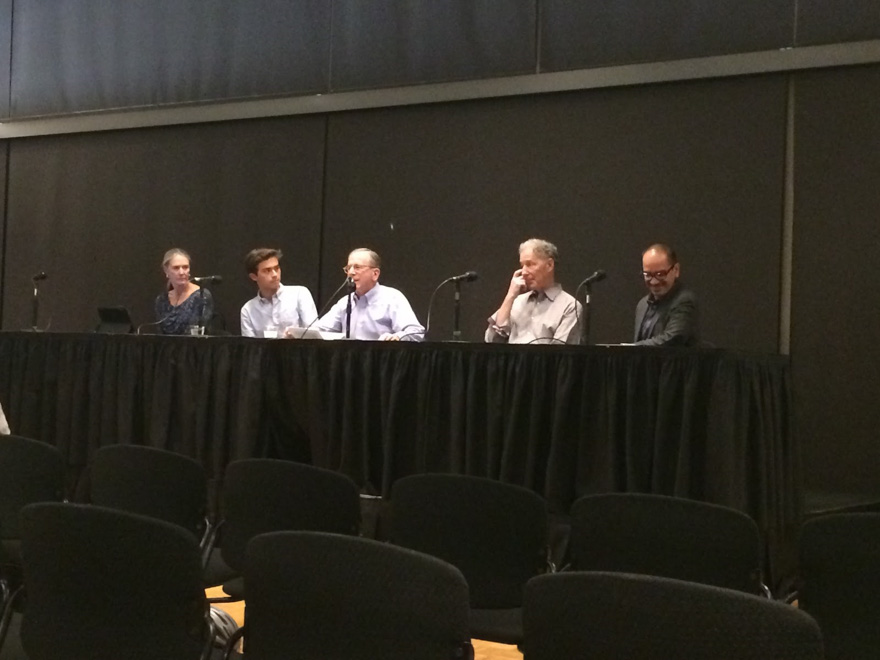
This Wednesday, 30 students attended the Presidential Search Committee town hall hosted by the ASSU — filling only one-third of the room. Despite this, students had a lively discussion that ranged from personal attributes they wanted to see in the next president to soul-searching on the university’s future and its place in the world.
The town hall was the main opportunity for undergraduates to influence the decision on Stanford’s next president, and the ASSU had hoped to represent a wider swath of the student population.
“Looking at this room of empty chairs makes me feel that people are indifferent, or that students have lost hope that the student voice matters – it’s disappointing,” said ASSU President John-Lancaster Finley ’16. “What are the ways the next leadership can address that?”
“I think a lot of people didn’t even know this was going on. Maybe I just missed the message, but I only heard about this when [Finley] posted on our activist Facebook group,” said Kinsey Morrison ‘18.
“I’m not disappointed at all by the turnout. I thought we saw a healthy number for discussion, and some really insightful comments,” said Ramon Saldivar, a faculty member on the Presidential Search Committee.
Students on campus diversity
A central theme that emerged was the path Stanford should take beyond its present success.
“When you say many people wish for the university to stay in the same direction, does that mean continued primacy on a STEM-focused engineering education? How do you define ‘maintaining the vision’ here?” asked Natasha Patel ’16 in response to Committee chairman Isaac Stein’s opening remarks that Stanford was not seeking a major reversal under the next president.
“It was an inept choice of words,” Stein replied. “What I meant was that at Stanford today, there is a general sense that the University is doing a lot of things right. There are things it need to change, and certainly things it could do better. But we’re not looking for a turnaround person, we’re looking for a builder.”
Some of that room for growth lay in making Stanford more welcoming to students of different backgrounds and abilities. Sammie Wills ’16 spoke on the difficulties students and faculty of color face on campus: “I struggled with finding a faculty advisor [for comparative studies in race and ethnicity]. The people I wanted for faculty advisor don’t get tenure and had to leave.”
“I want for the next president to support students like me, because honestly I do not feel like this is a welcoming climate,” Wills said after reading out a list of suggestions that included clearer tenure track guidelines and more mentorship for faculty of color.
Stanford and the community
Beyond student life, students also shared their aspirations for Stanford’s impact on local communities and the world at large. Familiar calls to take the moral leadership on sustainability and campus sexual assault were heard, while others focused on Stanford’s relationship with East Palo Alto and gentrification in the Bay Area.
For William Brown ’18, this self-examination should begin closer to home.
“I had lunch with some workers from R&DE, and it was really good to talk to them,” Brown said. “Something important they said is that they felt like they’re pressured not to talk to us, about what’s wrong with Stanford. But I think it’s very important for us to have open environments with workers and students.”
In the absence of easy answers, Stein ended by affirming student voices.
“We want to hear from you directly, and lots of you had very concrete comments which were also very helpful,” Stein said, thanking the participants.
The response from the crowd was hopeful but ambivalent.
“It was actually better than I expected, and I think [the committee] was really listening,” Morrison said. “It’s one of the few chances we have to influence how $22.2 billion will be spent. But we don’t know what impact this will have yet, I guess we’ll have to see.”
Contact Fangzhou Liu at fzliu96 ‘at’ stanford.edu.
